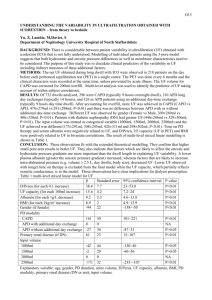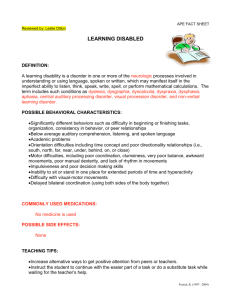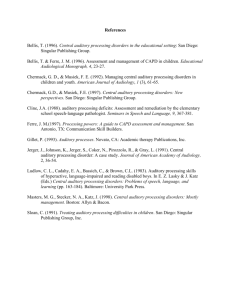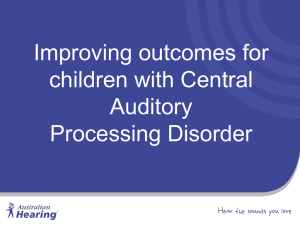CAPD for Canberra - no audio
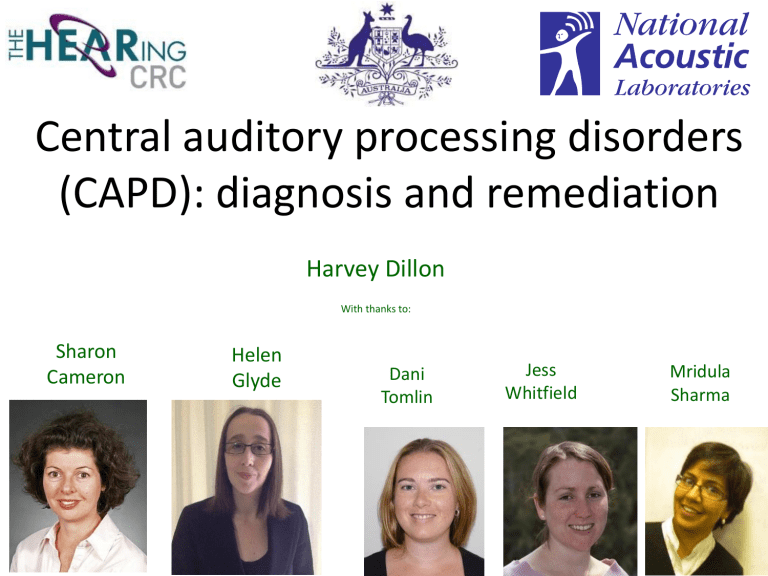
Central auditory processing disorders
(CAPD): diagnosis and remediation
Harvey Dillon
With thanks to:
Sharon
Cameron
Helen
Glyde
Dani
Tomlin
Jess
Whitfield
Mridula
Sharma
1
National Acoustic Laboratories
NAL www.CAPD.NAL.gov.au
2
National Acoustic Laboratories, Sydney, Australia
Presentation Overview
Central Auditory Processing Disorder (CAPD) ????
Spatial Processing Disorder (SPD)
• What is SPD and how does it relate to CAPD?
• What causes it?
• How do we remediate it?
Testing for CAPD ????
• Test batteries and remediation
• Cognitive ability, listening difficulty and academic success
Sound Scouts – a new quick online test
3
What is CAPD?
An Auditory Processing Disorder
(APD) is a deficit in the way the neural representations of sounds are processed by the brain
“What we do with what we hear.“
(Katz, Stecker & Henderson; 1992)
Auditory System:
Central Pathways
Cortex: Complex detection
Thalamus: Auditory and visual map integrated, relayed to cortex
SC: Visual spatial map
IC: Form full spatial map,
Parallel processing paths join,
History dependent
VNLL: Fed by contralateral CN
MSO: Detect interaural time
LSO: Detect interaural level
AVCN: Frequency analysis,
PVCN: Timing well preserved
DCN: Inhibitory circuits, pinna cue detection?
Parallel processing
Needs to be fed to develop & maintain
OK
Lateral lemnisci
Something not OK
APD creates difficulty in listening
i.e. hearing with intent to extract information
• difficulty understanding speech in noise or reverberation
• difficulty hearing on the phone
• inconsistent or inappropriate responses to requests for information
• difficulty following rapid speech
• frequent requests for repetition and/or rephrasing of information
• difficulty following directions
• difficulty learning a foreign language or new words
• problems localizing sound
• difficulty detecting the subtle changes in prosody that underlie humor and sarcasm
• difficulty maintaining attention
• a tendency to be easily distracted
• poor singing, musical ability, and/or appreciation of music
• academic difficulties, including reading, spelling and/or learning problems
AAA (2010)
Assessing children with CAPD
• Audiometric test (to rule out hearing loss)
• History
• A test battery
• Sometimes proposed to instead make the assessment symptom-based (e.g. use a questionnaire)
– CHAPS, SIFTER, LIFE, CCC2, Fisher’s checklist
Disorders other than APD (e.g. language disorders) can also create difficulty in listening
• Language disorders
• Attention deficit disorder
• Auditory working memory deficit
• Executive function deficit
• Autism spectrum disorder
• Low IQ
Difficulty of relying on symptoms
Diagnosing CAPD by symptoms?
Questionnaires (or other ways to gather symptoms) might be able to confirm there is a problem, but can’t tell us the cause.
Event
Response by child
Interpretation by observer
Cognition
Acts
(inappropriately) based on what was heard
Is not very smart
Auditory processing Can’t follow instructions
Child fails to understand an instruction
Asks for repetition of instruction
Does nothing
Poor concentration
Daydreams
Language
Misbehaves Badly behaved
11
CAPD or AD(H)D?
Auditory processing deficit
Attention deficit disorder
Understanding is difficult
Don’t pay attention
Don’t pay attention
Relation between APD and Attention Disorder
Auditory processing disorder
58 20
Auditory attention disorder
51
13 19
101 children with listening difficulties
Gyldenkaerne et al. (2015)
5
14
4
2
Visual attention disorder
25
No disorder
24
13
What do we include in “Auditory Processing”?
Rapid spectrotemporal analysis
Slow temporal analysis
Localisation ability
Stream segregation
Attention
Working memory
Executive function
What do we include in “Auditory Processing”?
Auditory Processing Ability
Rapid spectrotemporal analysis
Slow temporal analysis
Localisation ability
Stream segregation
Cognitive ability
Attention
Working memory
Executive function
Causation …….. unknown
Cognitive abilities
Auditory processing abilities
Language abilities
Academic abilities
Reported listening ability
What is APD?
"When I use a word,' Humpty Dumpty said in rather a scornful tone, 'it means just what I choose it to mean — neither more nor less."
"The question is," said Alice, "whether you can make words mean so many different things."
ASHA (2005)
“(C)APD is a deficit in neural processing of auditory stimuli that is not due to higher order language, cognitive, or related factors."
Moore, Ferguson et al (2010)
“What is currently called APD, for individuals without known neurologic lesions, should be redefined as primarily a cognitive disorder, rather than a sensory disorder.”
17
My comment …
It is not productive to define APD as either not involving cognition, or as only involving cognition.
Rather, focus on finding out
• Whether individual children have difficulty listening,
• Why they have difficulty when listening, and
• What can be done to change that.
18
0.0
-0.5
-1.0
-1.5
-2.0
-2.5
-3.0
-3.5
Teachers’ CHAPS scores – children referred to Great Ormond
Street Hospital for APD assessment
Same difficulty
Slightly more difficulty
More difficulty
Noise
No APD
APD issues
APD diagnosed
Quiet Ideal Multiple
PROBLEM
Memory Attn Span
Considerably more difficulty
Parents’ CHAPS scores – children referred to Great Ormond
Street Hospital for APD assessment
0.0
-0.5
-1.0
Same difficulty
No APD
APD issues
APD diagnosed
Slightly more difficulty
-1.5
-2.0
More difficulty
-2.5
-3.0
Considerably more difficulty
-3.5
Noise Quiet Ideal Multiple
PROBLEM
Memory Attn Span
CAPD
SPD
In review
• CAPD is an umbrella term for a variety of deficits in auditory processing that cause listening difficulties
• Symptoms shared with other disorders
• Some differences of opinion in what should be included under the umbrella
Spatial Processing Disorder
:
Diagnosis, cause, remediation
National Acoustic Laboratories, Sydney, Australia
Spatial Processing Disorder –
Unique amongst CAPD because we:
Know its major cause
Can diagnose it, unrelated to cognitive ability
Have extensive normative and reliability data
Can remediate it (blinded, randomized trial)
Remediation generalizes to real life
25
National Acoustic Laboratories, Sydney, Australia
Catalyst
The Australian Broadcasting Commission
26
National Acoustic Laboratories, Sydney, Australia
Assessing Spatial Processing Ability
27
National Acoustic Laboratories, Sydney, Australia
Listening in Spatialized Noise – Sentences Test
(LiSN-S)
Test ability to separate target stimuli from distracting stimuli that arrive from other directions.
Test design to differentiate this ability from other problems.
28
LiSN-S Measurement Screen
Two Distracters at 55 dB SPL
SRT ≡ average SNR
Level of Target
(adaptive)
30
National Acoustic Laboratories, Sydney, Australia
Four LiSN-S Conditions
Same Voice
D1 T D2
Same
Direction
Talker Advantage
Low
Cue
SRT
Different Voices
D1 T D2
T
T
High
Cue
SRT Different
Directions
31
National Acoustic Laboratories, Sydney, Australia
Anticipated Advantage of Using Difference Scores
• Four base scores likely affected by:
• Cognitive abilities (memory, IQ, attention)
• Language abilities (vocabulary, closure skills, second language)
• Three difference scores relatively immune to these
32
LiSN-S results profile: spatial processing disorder
33
Spatial Advantage
( ≡ Spatial Release from Masking)
18
17
16
15
14
13
12
11
10
9
8
Australia
Nth America
Age Group
National Acoustic Laboratories, Sydney, Australia
LiSN-S Cut-off Scores
22
20
18
16
14
12
10
8
6
4
0 10 20 30
Age
Cameron et al. 2011
40 50 60 70
38
LiSN-S Spatial Advantage Test-Retest Reliability (n=95)
Paired Difference = 0.3 dB p = 0.178
r = 0.2
Critical Difference Score = 3.3 dB
39
CHILDREN WITH SPATIAL
PROCESSING DISORDER
National Acoustic Laboratories, Sydney, Australia
Children with Spatial Processing Disorder
Nine children aged 6 to 11 years experiencing listening difficulties in class relative to peers who had no learning or attention disorder and WISC IQ >90 on all subscales
(SusAPD group).
Eleven children with confirmed language, memory or attention disorders, and WISC IQ overall score >90 (LD group).
Assessed on LISN-S and results compared to 70 agematched controls.
Assessed with a traditional (C)APD test battery
National Acoustic Laboratories, Sydney, Australia
LiSN-S vs. Traditional Battery (LD Group)
LD Group
6
4
2
0
-2
-4
-10
-12
-6
-8
Median 25%-75% Min-Max
Cameron & Dillon (2008)
National Acoustic Laboratories, Sydney, Australia
LiSN-S vs.Traditional Battery (sus CAPD Group)
LiSN-S vs. Traditional Battery
6
– SusAPD Group
0
-2
-4
-6
4
2
-8
-10
-12
Median 25%-75% Min-Max
Cameron & Dillon (2008)
National Acoustic Laboratories, Sydney, Australia
Link between SPD and
Chronic Otitis Media (COM)
44
SPD and chronic otitis media (COM)
• 50% of children (24/49) diagnosed with SPD at NAL reported a history of COM. (Dillon et al., 2012).
• 30% of children (15/50) previously diagnosed with COM at
University of Melbourne were diagnosed with SPD. (Graydon & Rance, ongoing).
• Spatial processing deficit worse for early onset age and longer duration of COM (n=35; Tomlin & Rance, under review).
• 6 yo children with history of COM have below average spatial advantage
(n=17; z= -1.0) (Kapadia et al, 2012).
• 13-17 yo adolescents with history of COM have below average spatial advantage (n=20; z= -0.75) (Kapadia et al, 2014).
• 10% of a population sample (9/90) of Aboriginal children from remote Australia diagnosed with SPD. (Unpublished data).
• 7% of a population sample (10/144) of Aboriginal children from regional Australia diagnosed with SPD. (Cameron et al., in review).
45
National Acoustic Laboratories, Sydney, Australia
Interpretation Based on These and Other Studies
Chronic otitis media
Fluctuating access to binaural cues reduced effectiveness in better-ear glimpsing
46
National Acoustic Laboratories, Sydney, Australia
Remediation of SPD:
The LiSN & Learn Auditory
Training Software
47
National Acoustic Laboratories, Sydney, Australia
LiSN & Learn
• Deficit-specific remediation for SPD.
• Trains children to attend to a frontal target stimulus and filter out distracting talkers from left and right.
• Adapts to 70% performance level.
• Used in the home or schools/clinics).
• Provides detailed feedback, analysis and reporting.
48
LISN & Learn Game
Target at 0˚:
Distracters at
+ and 90˚:
Target: The horse kicked six wet shoes
National Acoustic Laboratories, Sydney, Australia
LiSN-S Results - Pre- vs. Post-Training
2
1
0
-1
-2
-3
-4
LC SRT HC SRT Talker
LiSN-S Condition
Spatial
Pre-Training
Post-Training
3M Post-Training
Total
LC SRT p = 0.158
Talker Advantage p = 0.981
HC SRT p = 0.0002
Spatial Advantage p = 0.0002
Total Advantage p = 0.001
Cameron & Dillon
(2011)
52
National Acoustic Laboratories, Sydney, Australia
LiSN & Learn – Preliminary Study
•
•
9 children with SPD (6 to 11 years)
LiSN & Learn – 2 games/day, 5 days/week, 12 weeks
10 dB
Average SRT
First vs Last 30 Days p = 0.000052
Game Number
Cameron & Dillon (2011)
53
National Acoustic Laboratories, Sydney, Australia
Self-Report Questionnaire - Pre- vs. Post-Training
CAPD SSQ
4.0
Very
Hard
3.5
SSQ - Noise
SSQ - Quiet
3.0
Hard
2.5
OK
Easy
Very
Easy
1.0
0.5
0.0
2.0
1.5
Pre-Training Post-Training
SSQ
–
Listening in Noise:
Pre vs Post p = 0.0002 *
Post vs 3MP - p = 0.397
SSQ
–
Listening in Quiet:
Pre vs Post - p = 0.103
Post vs 3MP - p = 0.529
3M Post-Training
Cameron & Dillon (2011)
54
National Acoustic Laboratories, Sydney, Australia
Blinded Randomized Control Study
1.
2.
3.
4.
10 children (aged 6 yrs 0 mths to 9 yrs, 9 mths) diagnosed with LiSN-S as having SPD: a) b)
5 x LiSN & Learn (experimental group)
5 x Earobics (control group) a) b) c)
Questionnaires
Participant (LIFE)
Parent (Fishers)
Teacher (LIFE)
LiSN & Learn or Earobics training
– 15 minutes daily x
60 sessions
Re-evaluate LiSN-S and questionnaires post-training
55
National Acoustic Laboratories, Sydney, Australia
LiSN-S Results – Pre vs. Post Training
Earobics (n = 5) p = 0.5 to 0.7
Lisn & Learn (n = 5) p = 0.03 to 0.0008
Cameron, Glyde & Dillon (2012)
56
1.0
0.9
0.8
0.7
0.6
0.5
0.4
0.3
0.2
National Acoustic Laboratories, Sydney, Australia
Questionnaires – Post Training Improvements
25
20
15
10
35
30
-5
-10
5
0
Teachers
L&L = 16 pts;
Earobics = 7 pts; where 0 pts = “no improvement”
LiSN & Learn Earobics
Parents p = 0.028
Pre-Training
LiSN & Learn
Earobics
Post-Training
200
180
160
140
120
100
80
60
40
Children
Pre-Training
LiSN & Learn
Earobics
Post-Training
L&L = 31%; Earobics = 9% L&L = 22%; Earobics = 9% 57
National Acoustic Laboratories, Sydney, Australia
Disclosure
The National Acoustic Laboratories, is an Australian government laboratory
NAL licences the LiSN-S test to Phonak, and is paid a royalty on sales.
• NAL directly sells the LiSN & Learn training package through its web site.
58
In review
• Spatial processing disorder (SPD) can unambiguously be diagnosed
• SPD is very often caused by protracted otitis media in infancy
• SPD can be remediated
Testing for CAPD
A typical test battery
• Gap detection (GIN, RGDT)
• Dichotic perception (DDT, SSW, CST)
• Temporal ordering (FPT, PPT)
• Binaural processing (MLD, LiSN-S)
• Degraded speech (Compressed speech, LPFS)
• [Auditory memory (digits forward and reverse)]
CAPD if two tests failed by two standard deviations or more
Traditional approach to CAPD testing
History Audiometry
No
Exclude CAPD;
Refer elsewhere
Non-specific remediation and management:
• Classroom placement
• FM use
• Instruction style
• Soundfield amplification
• Auditory training software
Is there a problem that CAPD might explain?
Yes
62
Detailed test battery
Test result interpretation & diagnosis
63
Further problems with a large test battery
Increased demands on child’s attention
(The tests are often very boring!!)
Relevance of the normative data
Statistical implications of presenting multiple tests
- inflating Type I error rate.
Principles in constructing a test battery
64
Include tests where: poor results are linked to poor listening in real life diagnose conditions for which evidence-based remediation exists
NAL position statement on CAPD: www.CAPD.NAL.gov.au
National Acoustic Laboratories, Sydney, Australia
Test structure
LiSN-S high cue LiSN-S
Auditory memory
(digits forward and reverse)
Dichotic digits
Remediate
(L&L)
Remediate
(Memory booster)
Remediate
(FM …..)
Dichotic Digits and Cognition
4
6
Dichotic Digits Test
9
2
Dichotic presentation
Dichotic ability
Auditory working memory
Attention
IQ
4, 9
6, 2
Dichotic Digits Difference Test
4, 9
6, 2
Diotic condition
Auditory working memory
Attention
IQ
67
Correlations – DDDT and cognition
Dichotic Diotic
Attention - Prudence 0.37
0.32
Attention - Vigilance 0.34
Number memory forward
Number memory reverse
Non-verbal IQ
0.35
0.34
0.26
0.24
0.41
0.47
0.26
68
Dichotic vs diotic perception 1.0
0.5
0.0
2.0
1.5
-0.5
-1.0
-1.5
-2.0
School
Clinic
Dichotic presentation
Dichotic ability
Auditory working memory
69
Attention
IQ
-2 -1 0
DDDT integrated total (SD)
Diotic condition
Auditory working memory
Attention
IQ
1
R= 0.69
2
National Acoustic Laboratories, Sydney, Australia
FM useage
Hornickel and Krauss
(2012; PNAS)
70
Results from a clinical service: prevalence and remediation effectiveness
National Acoustic Laboratories, Sydney, Australia
Australian Hearing’s CAPD Service
• Operating in 42 Australian Hearing centers around
Australia since May 2012.
• Diagnosis, assessment and management of specific aspects of CAPD.
• Recruitment targets children experiencing difficulty hearing in background noise.
• Tests are chosen which:
1.
Have been shown to be associated with difficulties in real life.
2.
Are reliable, repeatable and relatively quick to administer.
3.
Lead to remediation that is backed by research evidence.
72
National Acoustic Laboratories, Sydney, Australia
Age Distribution
N=618
73
Mild
Conductive
Unknown
Auditory memory
26%
3
23
Passes and Fails
666
4 Hearing screening
Pass 636
Minimal
Sensorineural
LiSN - HC
Z ≥ -1 307
Z < -1
329
LiSN
Fail
120
Fail
167
Memory
Pass 349
Pass (not SPD)
209
Age
≥ 7 yrs 273
< 7 years
76
Testing discontinued
DDT
Dichotic deficit
20%
Pass 173
27%
Fail
100
SPD
19%
National CAPD service results: LiSN & Learn effects
LiSN & Learn training: COSI results
N = 34
Effect of Memory Booster training
77
COSI scores for Memory Booster training
Dealing with problems in understanding speech
Questionnaire / history Audiometry Measured disability
No
Exclude CAPD;
Refer elsewhere
Non-specific remediation and management:
• Classroom placement
• FM use
• Instruction style
• Soundfield amplification
Is there a problem that CAPD might explain?
Yes
FPT
Verbal
DDDT
Dichotic
SPIN
Hi Cont
LiSN-S
Master test battery
FPT
Hum
DDDT
Diotic
SPIN
Lo Cont
LiSN-S
Spatial
Advantage
LiSN-S
Talker
Advantage
?
?
Test result interpretation leading to
Deficit skill deficits nosed deficit
SPD a disorder-specific diagnosis
ARIA /
DIID
Top-down training
LiSN
Disorder-specific remediation
Pitch deficit
In review
• Big test batteries have big problems, and do not have an evidence-based path to remediation
• Evidence of benefit exists for:
– Training to overcome spatial processing disorder
– Training to improve working memory
– Use of FM (wireless remote microphone) systems
• More specific diagnostic tests and corresponding remediation methods are needed
CAPD test scores, listening in real life, academic performance and cognition
Subjects
• Clinical Group: (n=105)
– Children referred for clinical AP assessment
– Aged 7.0 to 12.9 years (Mean Age 8.9 yrs, ± 1.5)
Dani Tomlin
• Control group: (n=50)
– No reported auditory, listening or academic difficulties
– Aged 7.0 to 12.2 years (Mean age 9.1 yrs. ± 1.4)
• Peripheral hearing assessments all normal
Measures obtained
AP
Frequency Pattern Test (%)
Dichotic Digits Test (%)
Gaps In Noise (msec)
Listening in Spatialised Noise Sentences test (LiSN-S) (dB)
Masking Level Differences (dB)
Academic Results
Reading Fluency –WARP
NAPLAN
(Numerical scores)
Cognition
Non verbal IQ
Auditory Working Memory
Sustained Attention
(Quotient Scores)
Listening Ability
Questionnaires:
LIFE (child)
Fisher (Parent)
TEAP (Teacher)
(Total item scores)
Results need to allow for development & comparison of measures z scores
Source: Dani Tomlin
CAPD scores versus cognitive scores
DDT_L
RDT_R
FPT
GIN
MLD
LiSN_LC
LiSN_HC
LiSN_Spat Adv
Digit Span
Forward
0.43
0.36
0.25
0.09
0.15
0.27
0.12
0.00
Digit Span
Reverse
0.39
0.34
0.36
0.04
-0.05
0.18
0.11
0.03
Non-verbal IQ
0.38
0.28
0.43
0.13
0.07
0.28
0.22
0.08
Sus Aud
Atten
0.19
0.22
0.16
0.12
0.04
0.00
0.14
0.04
Mem avg
Atten avg
NVIQ
Path analysis
(model; no latent variable)
DDT avg
FPT avg
GIN avg
LiSN avg
Listening ability
Reading fluency
Mem avg
Atten avg
NVIQ
Path analysis
(results; no latent variable)
66% DDT avg
77%
FPT avg
97% GIN avg
88% LiSN avg
Reading fluency
49%
Listening ability
76%
P=0.12
Most metrics OK
In review
• Cognitive problems are often associated with failures on commonly used test batteries
Testing hearing is child’s play
Harvey Dillon Carolyn Mee
John Seymour Jesus Cuauhtemoc
Number of children first fit with hearing aids
200
150
100
50
350
300
250
0
<1 1 2 3 4 5 6 7 8 9 10 11 12 13 14 15 16 17 18 19 20 21 22 23 24 25
Age at first fitting
Hearing loss in those first fitted with hearing aids at 5 or 6 years of age.
Aim 1: develop a game to test for hearing issues in preschool and school-aged children
• Sensorineural hearing loss
• Middle ear disorders
• Auditory processing disorders
Aim 2: differentiate these conditions !
Basis of the test algorithm
1. Test of word recognition threshold in quiet
used to set level of rest of test
comparison with threshold for adult useful itself
2. Test of speech recognition in spatially separated noise
3. Test of tone perception in spatially separated noise
Expected results
Group
Normal
Calibration test Speech in noise test
√ √
Conductive x √
Tone in noise test
√
√
Sensorineural
CAPD
ESL, language impairment x
√
?
x x x x
?
√
PASS: Speech-in-noise average; tone-in-noise good
-8
-10
-12
-14
-16
-18
-20
-22
-24
2
0
-2
-4
-6
Normative data:
4 to 12 years
Speech in noise
-2
-4
-6
-8
-10
-12
-14
-16
-18
-20
-22
-24
-26
-28
5
5 10 15 age_inferred
20 25 30 35 40 45
Model: Speech_SNR=a+b*exp(-age/c) y=(-20.62)+(27.24)*exp(-x/(6.02))
Z scores
10
15
Age
20
25
30
35
40
45
50
55
60
Deriving results
Normal hearing children
Obtain scores
Regress against age
Test unknown child
Express scores as zscores
Combine zscores for calibration, speech and tone
Compare zscores for calibration, speech and tone
Overall pass, uncertain, or fail
Probable cause of fail
Overall results
Group Pass Inconclusive Fail Incomplete Total
Norm hear
Conductive
Sensori
Mixed
SIM_SPD
ESL
127
3
1
0
0
6
9
0
2
0
1
0
1
17
24
6
3
6
1
0
0
0
0
0
138
20
27
6
4
12
Correctness of single diagnosis
Sensori
Conductive
Mixed
ESL
SIM_CAPD
Sensori
10
0
4
0
0
Cond
1
6
0
1
1
CAPD/Lang
0
1
0
3
3
In review
Sound Scouts: A tablet-based hearing game that:
– Detects hearing problems
– Indicates the most likely type of hearing problem
– Recommends who to seek further help from
References
1.
2.
3.
4.
Dillon, H., Cameron, S., Glyde, H., Wilson, W., & Tomlin, D. (2012). Opinion: Re-designing the process of assessing people suspected of having central auditory processing disorders. Journal of the American Academy of Audiology (Accepted 17 June 2011).
Cameron, S., Glyde, H. & Dillon, H. (in press). Listening in Spatialized Noise- Sentences Test (LiSN-S): Normative and retest reliability data for adolescents and adults up to 60 years of age. Journal of the American Academy of Audiology (Accepted 18 May 2011).
Cameron, S. & Dillon, H. (in press). Development and Evaluation of the LiSN & Learn Auditory Training Software for Deficit-Specific Remediation of
Binaural Processing Deficits in Children: Preliminary Findings. Journal of the American Academy of Audiology (Accepted 29 April 2011).
Cameron, S., & Dillon, H. (2010). LiSN & Learn Auditory Training Software (Version 1.1.0) [Computer software]. Sydney, NSW: National Acoustic
Laboratories.
5.
6.
7.
Brown, D., Cameron, S. Martin, J., Watson, C., & Dillon, H. (2010). The North American Listening in Spatialized Noise – Sentences Test (NA LiSN-S):
Normative data and test-retest reliability studies for adolescents and young adults. Journal of the American Academy of Audiology, 21(10), 629-641.
Cameron ,S., Brown, D., Keith, R., Martin, J., Watson, C., & Dillon, H. (2009). Development of the North American Listening in Spatialized Noise -
Sentences Test (NA LISN-S): Sentence equivalence, normative data and test-retest reliability studies. Journal of the American Academy of Audiology,
20(2), 128-146.
Cameron, S. & Dillon H. (2009) Listening in Spatialized Noise – Sentences test (LISN-S) (Version 1.013) [Computer software]. Murten, Switzerland:
Phonak Communications AG.
8.
9.
Cameron, S. & Dillon, H. (2008). The Listening in Spatialized Noise – Sentences Test: Comparison to prototype LISN test and results from children with either a suspected (central) auditory processing disorder of a confirmed language disorder. Journal of the American Academy of Audiology,
19(5), 377-391.
Cameron, S. & Dillon, H. (2008). Spatial hearing deficits as a major cause of auditory processing disorders: Diagnosis with the LISN-S and management options. In R. Seewald & J. Bamford, eds. A Sound Foundation Through Early Amplification 2007. Proceedings of the Fourth
International Conference: Phonak AG, Switzerland, 235-241.
10.
Cameron, S. & Dillon, H. (2007). Development of the Listening in Spatialized Noise - Sentences Test (LISN-S). Ear and Hearing, 28(2), 196-211.
11.
Cameron, S. & Dillon, H. (2007). The Listening in Spatialized Noise - Sentences Test (LISN-S): Test-retest reliability study. International Journal of
Audiology, 46, 145-153.
103
Thanks for listening
The support of the Commonwealth Department of Health is greatly appreciated
CAPD.NAL.gov.au
- TV news story
- science TV show

